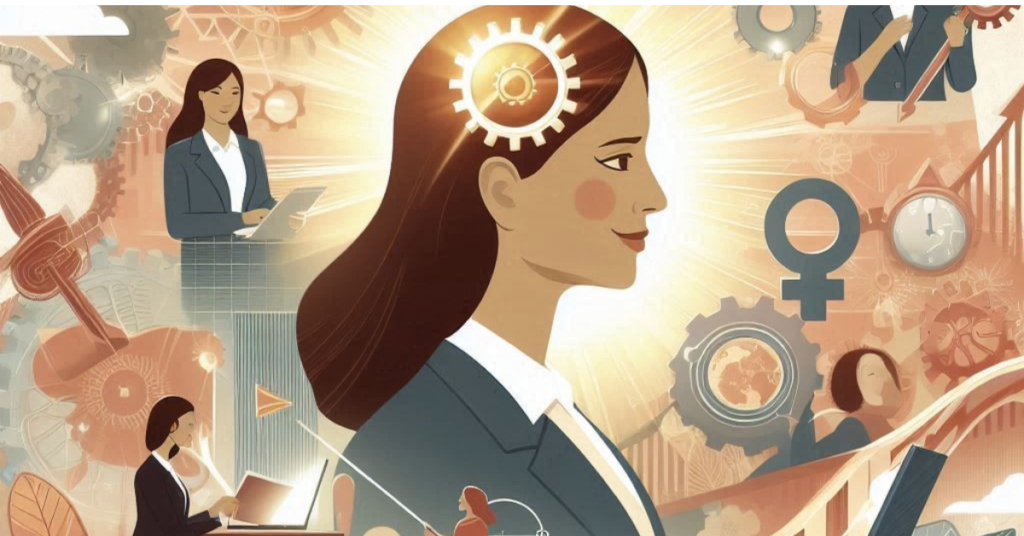
Abstract
Women leadership and employment is a hot topic of discussion at current situation in the entrepreneurship market. At this moment, woman have equally empowered themselves in the intellectual and decision making capacity that of man. This paper discusses the impact of woman leadership in organizational development. For this research, an in-depth analysis of the previous literature was done along with a small survey conducted among 10 woman leaders of various organizations.
The results have implication for individuals and organization that empower woman to lead and organization in an impactful way. Stakeholders might take their decision to select correct leader, keeping gender based decision at bay for choosing the correct leader helping to develop the organization. The research article includes findings, and conclusions that result from analysis and interpretation of findings from the survey and its connection to the past literature.
Keywords: Woman leadership, Women empowerment, Organization development, Impactful leadership
Introduction
Leadership can be defined as the ability where an individual can influence a group of people or an organization to achieve desired goal. It is usually attained by a person with senior positions.Leadership is sometimes also described as a skill to influence others through their action but it cannot be referred as a position of holding power. However, it can be performed by both men and women in equally efficient way. Power is mostly described in the forthright way suggested by political scientist Robert Dahl: “A has power over B to the extent that he can get B to do something that B would not otherwise do.”
The completion of the work in this situation is done inspite of the unwillingness of B.This can be called as a power but this is not a leadership.According to the information provided by Nepal Economic Forum on ‘Nepal’s Position: Women, Business and Law 2023’ the socio economic status of women in 2015 was 49.4% which gradually increased to 55.6% in 2018 and getting higher to 80.6 %in Women, Business and Law. This paper provides clear understanding about the importance ofhaving women in these positions for the development of organization.
Background
Customarily, there were very few women in senior positions where they could express themselves and accomplish task with their initiation. Despite so many achievements in various professions, women face gender discrimination.The era of only men being in leadership position has completely turned upside down. The expedition of Nepal towards gender equality remarked the emerge of feminist manoeuvrestarted in 1900s, for promoting women’s right. The movement resulted transformative journey to break free from all the constrains they had in the past.
This paper commences with a detail review on gender and leadership styles and organizational development. It is followed by the research methodology, findings and discussion and finally the conclusion and recommendation.
Research objective
The primary objective of this research is to explore:
- Women’s leadership impacts crucial factors of organizational growth.
- Data-driven insights show that female leadership promotes employment engagement, creativity, accountability, and goal success.
- Women’s leadership problems and barriers.
Scope and Importance
The facts have proved gender diversity in organization drives to better result compared to the organization only with male leaders.The importance of this study is not only the discussion as women or social issue but it is regarded as the economic issue in the recent organizational development.

Methodology
The methodology followed by this research is survey. Focused on generating a qualitative discussion, this research was conducted among 10 women leaders from various organizations. Their responses were recorded, studied and compared to the literature findings for analysis and further information generation.
Data Collection
For the purpose of collecting data, a survey form was handed over to the women leaders from various organizations from different industries like Education, Social Organization, Media house and private business firm. Before the submission of form the participants were ensured about maintaining the confidentiality of the information provided by them. The questionnaire was designs with 15 relevant questions which would approximately take around 30 to 45 minutes. The responses from the survey were carefully recorded, studied and analysed on the basis of individual responses and the findings from the related literature.
Data Analysis
The qualitative data obtained from the survey was analyzed on the basis of patterns, repeated iteration of any specific concerns or issues by the female leaders. These were then carefully segmented and individually studied and compared to the findings from the past literature concerning the similar concerns.
Literature review
In the past few years, the interest of female leadership has been a growing among the individuals and organizations. This research paper focuses on the responses collected through 10 participants based in Nepal only. The research focuses on the development of an organization under female leaders and the circumstances that can be observed. Various articles in the past have also discussed a wide range of findings on the same topic. Those findings are discussed here under the literature review section of this paper. The research is also backed by a couple of theoretical frameworks that explain the gender specific ideology of leadership.
Literature Review
Women Leadership and its development has been a topic of discussion among the literatures. The literature findings on the impact created by the leadership on the organizational development have been discussed in this section.
When men and women share a leadership role, Kanter (1977) says that managers are less biased because they follow the rules for the role instead of their gender stereotype. Kanter (1977) says that differences in behavior between men and women are actually caused by structural positions, not differences in gender. Women act in ways that show that they are less powerful because that is how they are often placed. The biggest study of how diversity affects group performance found that gender diversity has no effect on performance outcomes that can be measured objectively but has a negative effect on performance outcomes that can be measured subjectively (van Dijk, van Engen, & van Knippenberg, 2012).
People in an organization often think that women are bad leaders because of how they dress, talk, or represent fashion (Chin, 2011). Eagly (1987) says that women leaders were judged differently and less favorably than men leaders, even when they did the same things as men leaders. Women can lead while balancing work, caring for others, meeting role expectations, being connected, and being a part of more than one community (Wells & Fleshman, 2020).
We cannot know if women usually have interest in top leadership position or not till theyrecieve the opportunity without having to make complete sacrifices on personal and family factors disproportionate to that of men leaders.Traditionally men had an authoritative approach of leadership where they would give space to their team members for work completion and women leaders would generally stay back and women would be in lower-key leadership staying invisible(Neohane, 2020).
The work load that has to be completed at home are considered to be their sole responsibility which makes their time management difficult unlike men. The traits in men are noticed to be aggressive, ambitious, forceful controlling and independent where women had traits like helpfulness, humble, generous, family oriented and the decisions are taken for the welfare of others (Thomas & Das, 2024). Female leaders were found to have emotional intelligence. The ever learning attitude is a vital factor that helps in organizational development. Their decisions were found to be favorable according to the organizational culture (Thomas & Das, 2024).
According to the January 20, 2014 Gallup study, the result of 800 business firms from two companies had better financial performance than compared to the company which was dominated by only male. An October 2016 Catalyst , study of Fortune 500 companies report based on factors like return on sales, return on equity and return on invested capital presents that the company had highest number of women board directors had greater finanacial performance than that of the company having more men board directors (Elias, 2018).
According to the literature based facts, it has been clearly evident that, women leadership has proven to be better than the male leadership in terms of the emotional intelligence they posses and the natural multi-tasking capability they possess. They prove themselves to be oriented towards the developmental result of any organization they involve with.
Facts posing the emotional intelligence present a basis for the counter argument associated with the social expectations with the role of females. Despite being a leader in an organization, they are equally expected to provide the care giving to the members of the family and balance their work life in terms of time and dedication separation for the organization and the family.
Empowering the women to become a leader, a few adjustments in the societal expectation and the workplace can prove that the women intelligence would prove to provide better opportunity for organizational development with women leaders. These adjustments could be favorable work place according to the natural expectation and situation of a female employee to time flexibility in accordance to the need and the call of a situation in one’s personal as well as professional life. Provided that women are equipped with these required adjustments, female leaders can lead a better organization than those led by the male leaders.
Theoretical Framework
The theoretical framework that supports the basis of this research are, Social Role Theory, and Transformational leadership theory.
Social Role Theory
Originally developed by Eagly in 1987, this theory explains that gender roles influence behavior in the leadership positions. According to this theory, leaders behave differently as per the gender they represent which is due to societal expectations associated with a particular gender. Women are taken to be more nurturing, and communal enhancing the employee satisfaction and organizational development.
Transformational Leadership Theory
Introduced by Burns during the era of 1978, this theory suggests that leaders who inspire and motivate employees towards a shared vision foster organizational development. Women leaders are often associated with the transformational leadership theory due to their empathetic, inclusive and mentoring behavior during the tenure positively changing the employee engagement and organizational growth.

Data Analysis
The data obtained through the survey filled by 10 participants, and a detailed interpretation of the data from literature, the findings can be categorized and analyzed under the following headings.
Gender specific challenges
Despite the various benefits of women leaders in an organization, women face numerous challenges that are more often gender specific. The societal structure takes women to be the supreme manager of the house who is often responsible for rearing of children to managing the pantry and other various household chores. Keeping both the roles in balance and equally well performed is a major challenge faced by women leaders. With the responsibility of carrying forward the generation of a family, it becomes difficult for a women leader to handle roles with equal performance on both the ends.
Women leadership impact on employee engagement
It has been a critical title to discuss that women engagement is crucial to organizational development. Due to a women’s nature of nurturing and taking higher responsibility, it automatically makes it sure for a women to more concern towards the well being and development of employees. Therefore, under women’s leadership employee find themselves more engaged for their own and organizational development.
Gender specific impact on leadership style
According to the responses of the survey, participants have claimed that women leader is more calm and tolerant towards the situation. Due this calmness and responsible outlook in the leader, employees find it more motivating and convenient to work. Women are more calm towards problems and patient to observe the solution impact the working environment of any organization.
Working environment in the organization
While studying the responses from the participants, it has been evident that women leaders create a different impact on the working environment in the organization. As women come from a different societal expectation then the male leaders, they bring diverse perspectives and collaborative approaches fostering inclusive environments. They inspire innovation and resilience in a organization. Female leaders are able to deliver impactful results through any organization. One of the major discussions is that, female leaders encourage more females to work and work for making the work place more female employee friendly as they may have different hindrances than male, for instance could be menstruation phase and motherhood.
Unconscious Gender Biasness
Supported by the literature report by various authors and also claimed by the participants that despite various supporting agent and organizational structure, unconscious gender biasness prevails in the society which impacts women leadership. A certain attitudes and stereotypes affect peoples’ understanding and actions regarding a gender role. Questions on women’s physical strength and different kinds of time constraints are also raised while discussing the female leadership in an organization. Due to a wide range of topics like, marriage, motherhood, family responsibility and many to name in the list females are treated in despair with regards to salary, technical roles in an organization or support the leadership.
Work life balance
Due to various reasons, at times it becomes difficult for a woman to balance the demand of a leadership role along with the personal responsibilities specially associated to care giving roles in a family. While female leadership and women empowerment are appreciated and hot topic of discussion in the organizational setting, social expectations from the female is not viewed as less important with regards to the leadership role expectation from a female leader. Managing both professional and personal obligations, which limit the availability of females on the leadership roles.
Conclusion
On the basis of the survey report and the comparison drawn from the study of past literature, it is evident that women as leaders can make a difference in the work environment and employee engagement ultimately, resulting the organizational development.
However, this conclusion cannot be taken to be the final say. While various organizations are registered under women ownership and claim to enhance women entrepreneurship, literatures have shown that those data are only the ones presented in papers. While the firms and industries are registered in female names, these are run and owned by male leaders themselves and the purpose of registration is only tax subsidy from the government.
Despite the fact that the paper speaks about higher number of women entrepreneurs, there are various seen and unseen barriers that compel a woman to get rid of or never take that leadership role. Some natural, some man-made and some social boundaries are majorly responsible in holding these women to grow as leaders.
Contrary to the boundaries created and the facts studies, through the participants’ responses, it is obvious that woman leaders can support organizational development more than the male leaders due to their calm, empathetic and patient nature. If the natural boundaries like expectations associated with nurturing a child or time flexibility for similar roles or creating friendly and favorable work places supporting these factors, woman leadership can uplift the scenario of organizational development.
Also, for women to foster as the qualitative leader they can be a few societal support would also play a binding role. Instances can be nurturing roles can be shared among both male and female member of the family. Assumption of being or not being a standard woman on certain achievement in personal and professional errand should less be the topic of talk. These factors considered woman leaders can transform the leadership expectation and result, leading to higher organizational development.




